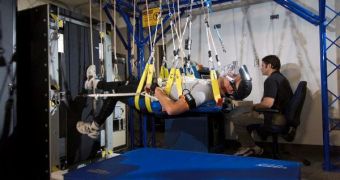Extreme sports fanatics would really enjoy this new invention, as it turns a horizontally-standing running treadmill into a vertical one, or even a sideways one. Workouts will never be the same! Don't get to excited though, I don't think you will find this baby in any gyms any time soon. NASA has been developing the vertical treadmill, in order to solve one of the biggest problems related to weightlessness, while astronauts conduct long time space missions.
The loss of muscle tone and bone mass. We might not always enjoy gravity on Earth, however as it turns out it is a key component in the appearance and evolution of life on our planet. Nonetheless, the presence of gravity doesn't always ensure that one may maintain its muscular tone. For example, the same results can be obtained by spending long periods of time in a still position. Lying 90 days or more in bed could present some difficulties for people while trying to walk.
In some cases, astronauts may even become physically impaired, practically becoming unable to work and bone loss may take as much as a few years to recover fully. Fortunately, NASA and the Russian space agency in particular found out about such effects some decades ago, and currently astronauts onboard the International Space Station work out at least two hours a day, in order to remain physically fit. Treadmill and stationary bicycles are the preferred devices.
Albeit working out in weightlessness conditions is not as easy as it looks on Earth, and the two hours limit imposed by NASA is simply too great in relation to the obtained results. The Exercise Countermeasures Project at Johnson Space Center and the Glenn Research Center is aiming to improve the workout devices, by simulating weight training environment, in order to minimize the crew time and resources.
The vertical treadmill design is basically a idea borrowed from the Russia's Institute of Biomedical Problems, which tested it on volunteers that have been lying in bed for up to 90 days. People are being held in a horizontal position with the help of vertical cables. The Standalone Zero Gravity Locomotion Simulator also pushed the feet of the volunteers towards the runway of the treadmill in order to recreate space station conditions, or ever the Moon's gravitational pull.
Treadmill designs could in fact be tested in zero weight environments, such as in the Vomit Comet, but the short period of weightlessness, 30 seconds or so, makes tests unpractical and expensive as well, thus NASA will just have to limit its testings to the vertical treadmill for now.

 14 DAY TRIAL //
14 DAY TRIAL //